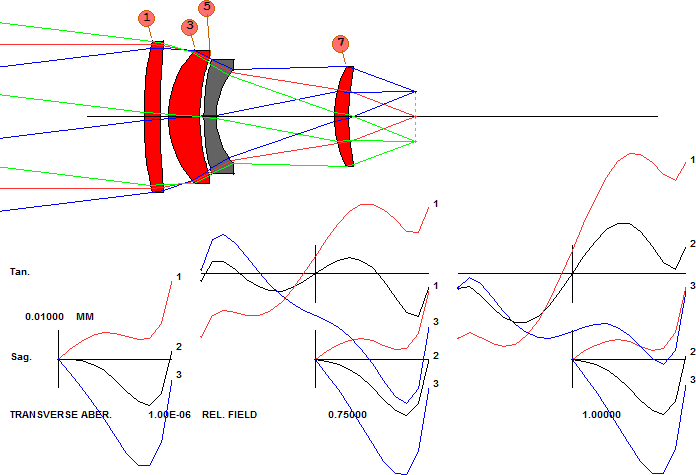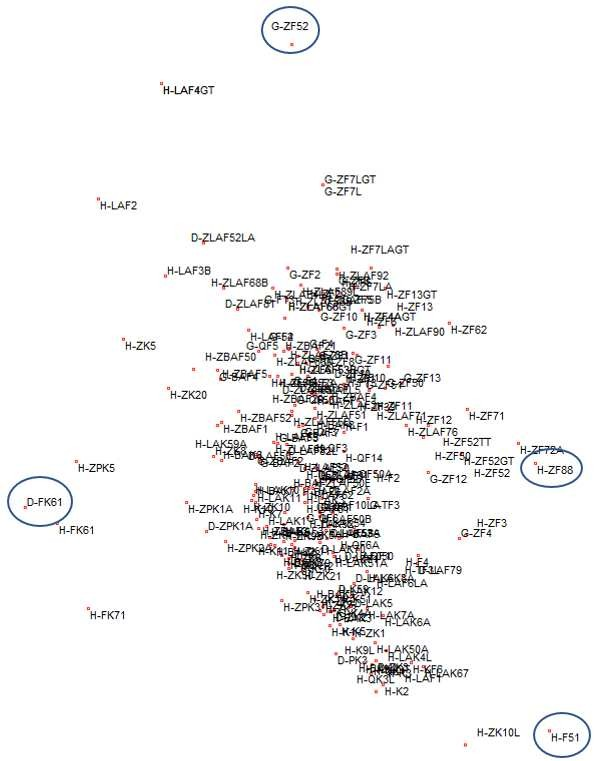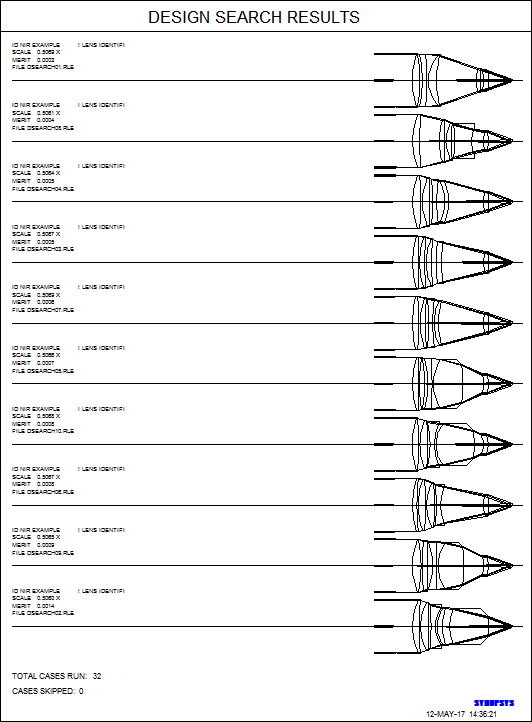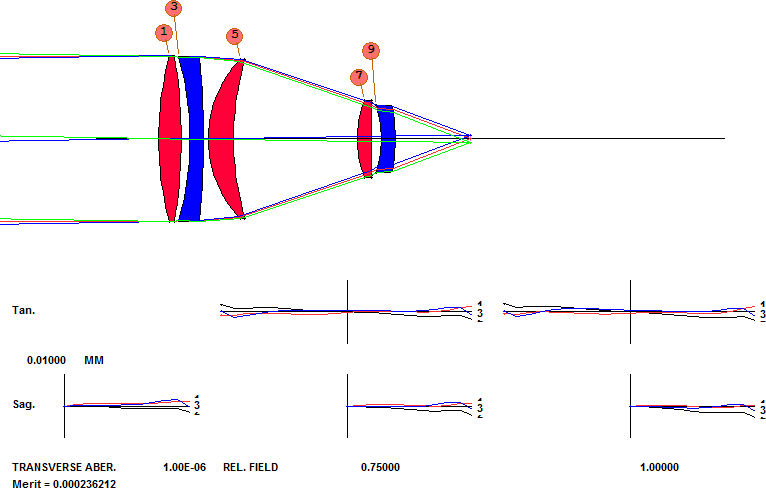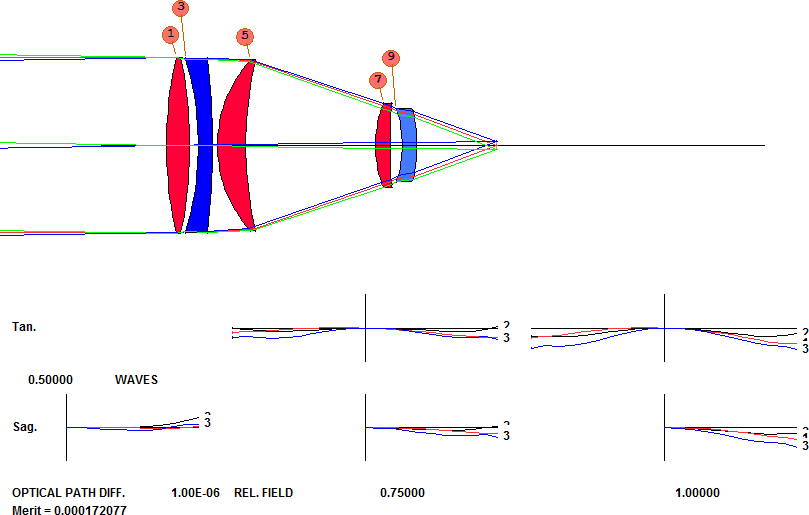近红外透镜设计:SYNOPSYS 光学设计软件
}^ G&n';J
第8课展示了如何设计用于可见光谱的复消色差物镜。现在我们将设计一个用于波长1.06到1.97微米范围内的近红外透镜。 ��5�,1��q%
设计红外透镜时的挑战是寻找在光谱范围内有用且其成本吸引人的光学材料。 本课程的任务是重新设计现有透镜,用普通光学玻璃替换一些不需要的材料。 参考系统为1.RLE,ID为MIT 1 TO 2UM LENS。 您可以检查该透镜并检查其性能。 将光扇图的比例设置为0.01 mm。 "�J (.dg]"
该透镜有三个材料微ZNS的透镜和一个材料为AS2S3透镜,共有四个透镜。我们希望尽可能避免使用这些材料。 我们需要匹配的一阶属性如下(尺寸以mm为单位): &+�>�)H$5�
• Entering beam radius 17.5
�20p/p~�<
• Chief-ray angle 0.935 degrees ?{�M!syD�<
• Back focus distance 16.3 sT"�h)I)]*
• Cell length 50 J�dW:%�,sv
让我们从头开始,而不是尝试改变当前透镜中的材料,所有这些材料的折射率都大于2.0。 为此,我们将使用设计搜索程序。 但首先我们必须有些选择:如果我们只是运行DSEARCH并让它找到模型玻璃,它就不会得到任何在NIR上产生重大影响的不寻常的玻璃。 (该模型代表了所有玻璃的平均值。)所以我们必须引导它。 F�W�zf8*�^
打开玻璃表显示(MGT),选择Guangming列表,然后单击图表按钮并选择显示的选项。 8nc�gTCH:�
数据现在不在屏幕上,因此单击显示并使用鼠标滚轮缩小,直到看到一组红点。 然后用鼠标右键平移放大。单击“Full Name”按钮。 你应该看到下面的显示。 B)`^/�^7��
记下圈出的四个玻璃名称:D-FK61,G-ZF52,H-ZH88和H-F51。 那些肯定与其它的玻璃不同。 我们将指示DSEARCH仅使用其中两个,然后使用全部四个进行全面的玻璃搜索。 *^�5.�.0du
这是我们的SEARCH输入: ]VS$� ?wD�
CORE 16 PROJ �U�?:�<clh
DSEARCH 3 QUIET ! the best lens will show up in library location 3 (and also in PAD) SYSTEM ! system requirements follow 58 Rmq/6s�
ID NIR EXAMPLE ! lens identification OBB 0 .935 17.5 ! specify the object V`z2F'v��T
WAVL 1.97 1.53 1.06 ! and the wavelength range UNITS MM 'L0{E�d+9�
END 9p5{,9�.3*
(G:�K��?o)
GOALS ! here we set the goals >�{��]m�N5
ELEMENTS 5 ! since glass has a lower index, we’ll ask for 5. FNUM 1.428 <r{ )*�]#l
BACK 16 .1 YOH�YXhc{S
TOTL 50 .1 ����=2=n �
STOP FIRST ! there seems to be no reason to let the stop position vary STOP FIX ! so we put it in front and keep it there Kzd`|+?'`M
NPASS 100 y~N�,=5>�j
ANNEAL 200 20 ]
x_���WO_
RSTART 300 ! a useful starting radius, JV#)?/a$�z
TSTART 1 ! and this thickness on each element to start with QUICK 60 90 (�~�>L \]!
FOV 0 .5 1 fjAJ�ys)Q�
FWT 2 1 1 (mJ�qI)m8�
GLASS POS ! positive elements will use this glass type G D-FK61 @B�Z6�{@�*
GLASS NEG ! and negative this type. G H-ZF88 t $�+�46**
END vZns,K#4H\
>cPB:kD'�
SPECIAL ! here we give requirements that are not defaults )A4WK+yD$z
ACM 3 .1 1 ! auto edge control (AEC) and center thickness control (ACC) are defaults ACA ! but we add to these ACM, so thicknesses do not get too thin, ACA, 6*,8 ��H&�
ASC ! so rays do not approach the critical angle, and ASC so surfaces do not END ! get too close to the hemisphere point. M7(�vI�4V�
�J�0U9zI4�
GO ! this starts the process. PROJ S)0bu(a`Z,
P�e !eID8�
在不到一分钟的时间内,该过程生成了它找到的10种最佳配置的系统图片。 )oSU�hU26}
我们现在有一个非常好的5元件透镜,但它只有我们指定的两种玻璃类型。 现在是时候进行更全面的搜索了。 �&�!{wbm@
查看MACEARCH DSEARCH_OPT .MAC,DSEARCH为我们方便地构建了它,并且应该在新的编辑器窗口中打开。 L�w]:/�x�
PANT %8T:r�S���
VLIST RD ALL VLIST TH ALL END :��I5]|�pt
AANT AEC d/G��P.��d
ACC P qYW{�$K���
GSR 0.000000 2.000000 4 M 0.000000 nr>g0_�%�m
GNR 0.000000 1.000000 4 M 0.500000 Oifu ?f<r�
GNR 0.000000 1.000000 4 M 1.000000 �/AR;O4X+
M 0.160000E+02 0.100000E+00 A BACK
�0O>8DX�
M 0.500000E+02 0.100000E+00 A TOTL K'%�,�dn�
ACM 3 .1 1 ! AUTO EDGE CONTROL (AEC) AND CENTER THICKNESS CONTROL (ACC) ARE DEFAULTS ACA ! BUT WE ADD TO THESE ACM, SO THICKNESSES DO NOT GET TOO THIN, ACA, P���ZF>ia}
ASC ! SO RAYS DO NOT APPROACH THE CRITICAL ANGLE, AND ASC SO SURFACES DO NOT END �SrN;S �kS
SNAP/DAMP 1 [e��d%�"�f
SYNOPSYS 100 -��P�5VE�0
�W&]grG�2/
保存此MACro,保存名称为NIR_OPT.MAC。 这是我们执行GSEARCH时将反复运行的优化MACro,它将决定哪些玻璃应该放在哪些元件上。 z+1#p.F$@
现在创建一个新的MACro(输入AEE以打开一个新编辑器,并在下面输入数据) x,�js}Ml�w
CORE 16 1WPDML��uN
GSEARCH 3 QUIET LOG SURF 2�F��O.!�m
1 3 5 7 9 TD-d5P^Kek
END 8kih81tx"U
X9nt;A2TU+
OFILE 'NIR_OPT.MAC' NAMES z��Vs_|x="
G G-ZF52 G D-FK61 G H-ZF88 G H-F51 1{�%�EQhNd
y�g "u^*r&
END USE 2 GO �!�GMb��~�
";j/k�9DE�
透镜进一步改善。 到目前为止,透镜只有超过0.2波长的像差 M%:A�CLYP
看起来我们有一个解决方案! 几乎没有初级或二级色差。 我们成功地用普通玻璃替换了不需要的材料,同时性能也比原来好得多。 9�o�P8| <+
任务完成! 这是最终透镜的SPEC列表: vZC��2F���
SYNOPSYS>SPE e+=Oj�o�#�
� `�-4c}T
ID NIR EXAMPLE $6:j3ZTXrt
ID1 DSEARCH CASE WAS 0000000000000000000010110 22 �uG3t%Cm�N
LENS SPECIFICATIONS: �UUv&�X+�Y
,:-S<]fS{_
SYSTEM SPECIFICATIONS zp4�Jd"XBX
��
:X�F;�v
OBJECT DISTANCE (TH0) INFINITE FOCAL LENGTH (FOCL) 49.9800 7I`��e5\ u
OBJECT HEIGHT (YPP0) INFINITE PARAXIAL FOCAL POINT 15.9992 �E/�(:\Cm^
MARG RAY HEIGHT (YMP1) 17.5000 IMAGE DISTANCE (BACK) 15.9992 :�g�b7Py'C
MARG RAY ANGLE (UMP0) 0.0000 CELL LENGTH (TOTL) 50.0025 ReP7�c3D>p
CHIEF RAY HEIGHT (YPP1) 0.0000 F/NUMBER (FNUM) 1.4280 =�4y��M�E
CHIEF RAY ANGLE (UPP0) 0.9350 GAUSSIAN IMAGE HT(GIHT) 0.8157 �W)V�"QrFK
ENTR PUPIL SEMI-APERTURE 17.5000 EXIT PUPIL SEMI-APERTURE 24.7688 pq>��"GE�N
ENTR PUPIL LOCATION 0.0000 EXIT PUPIL LOCATION -54.7406 �El0|��.dW
4NwGP^�n��
WAVL (uM) 1.970000 1.530000 1.060000 Cd�i�u�*#f
WEIGHTS 1.000000 1.000000 1.000000 E$f.&�<>T
COLOR ORDER 2 1 3 b�r���<�,?
UNITS MM �F%6al,�8P
APERTURE STOP SURFACE (APS) 1 SEMI-APERTURE 17.53054 @y9_\mX�!s
FOCAL MODE ON 6{���}]QvR
MAGNIFICATION -4.99800E-11 POLARIZATION AND COATINGS ARE IGNORED. SURFACE DATA *�gu~7&yoP
�j$zw�(EkN
SURF RADIUS THICKNESS MEDIUM INDEX V-NUMBER s9qr;}U.`�
r�ayC1#��f
0 INFINITE INFINITE AIR �!���3�$Ph
1 83.04964 4.55863 D-FK61 1.48647 78.02 GUANGMIN �3Zdkf]Gh�
2 -90.13577 1.76097 AIR j�*�g5�f�
3 -61.20988 2.89016 H-ZF88 1.87811 26.89 GUANGMIN ve=o�H;zf�
4 -136.80545 1.00000 AIR -�GCGxC2u�
5 26.01458 5.71573 D-FK61 1.48647 78.02 GUANGMIN x��c8�MOm
6 83.59388 25.92496 AIR Fc�7mA��V=
7 24.21580 2.91205 D-FK61 1.48647 78.02 GUANGMIN �\�Q?r+�VZ
8 117.43058 2.36412 AIR !u~( \�Rb;
9 -24.23661 2.87587 H-F51 1.60755 25.46 GUANGMIN V;~��W,o�!
10 -40.27187S 15.99923S AIR )fpZrpLXE�
IMG INFINITE L��$��l'wz
lE�A�N�N�u
KEY TO SYMBOLS yFs��hV\��
Dx�/?0�F7V
A SURFACE HAS TILTS AND DECENTERS B TAG ON SURFACE S*�IF/ fu�
G SURFACE IS IN GLOBAL COORDINATES L SURFACE IS IN LOCAL COORDINATES �PR{��?��l
O SPECIAL SURFACE TYPE P ITEM IS SUBJECT TO PICKUP tV@!�jaj\�
S ITEM IS SUBJECT TO SOLVE M SURFACE HAS MELT INDEX DATA ,F.\�z�^\{
T ITEM IS TARGET OF A PICKUP T�NUzN���A
THIS LENS HAS NO SPECIAL SURFACE TYPES THIS LENS HAS NO TILTS OR DECENTERS SYNOPSYS> �+�I�5@Gys
4rc4}Yu,JI
如果这些透镜机械方面也是合适,问题就解决了。 �vEvVT]g[V
除了...... 1.97微米的透射率是多少? 输入FIND TRANS IN COLOR 1.它返回98.18%。 (此处膜层被忽略,因为透镜未处于偏振模式。)非常好! %rzC+=�*;�
但如果返回值太低怎么办? 好吧,然后回到玻璃地图并显示1.97微米的吸收 - 并选择具有较短数据条的玻璃。 毕竟,透镜设计完全取决于平衡,使用这些工具可以很容易地获得最好的工具。 i(2s"Uw�w,
@.a�[2,o_
详情请咨询:market@asdoptics.com 027-87582688 �0tC�+���?
GG�5wiN*2S
!B�P��/#��
|
